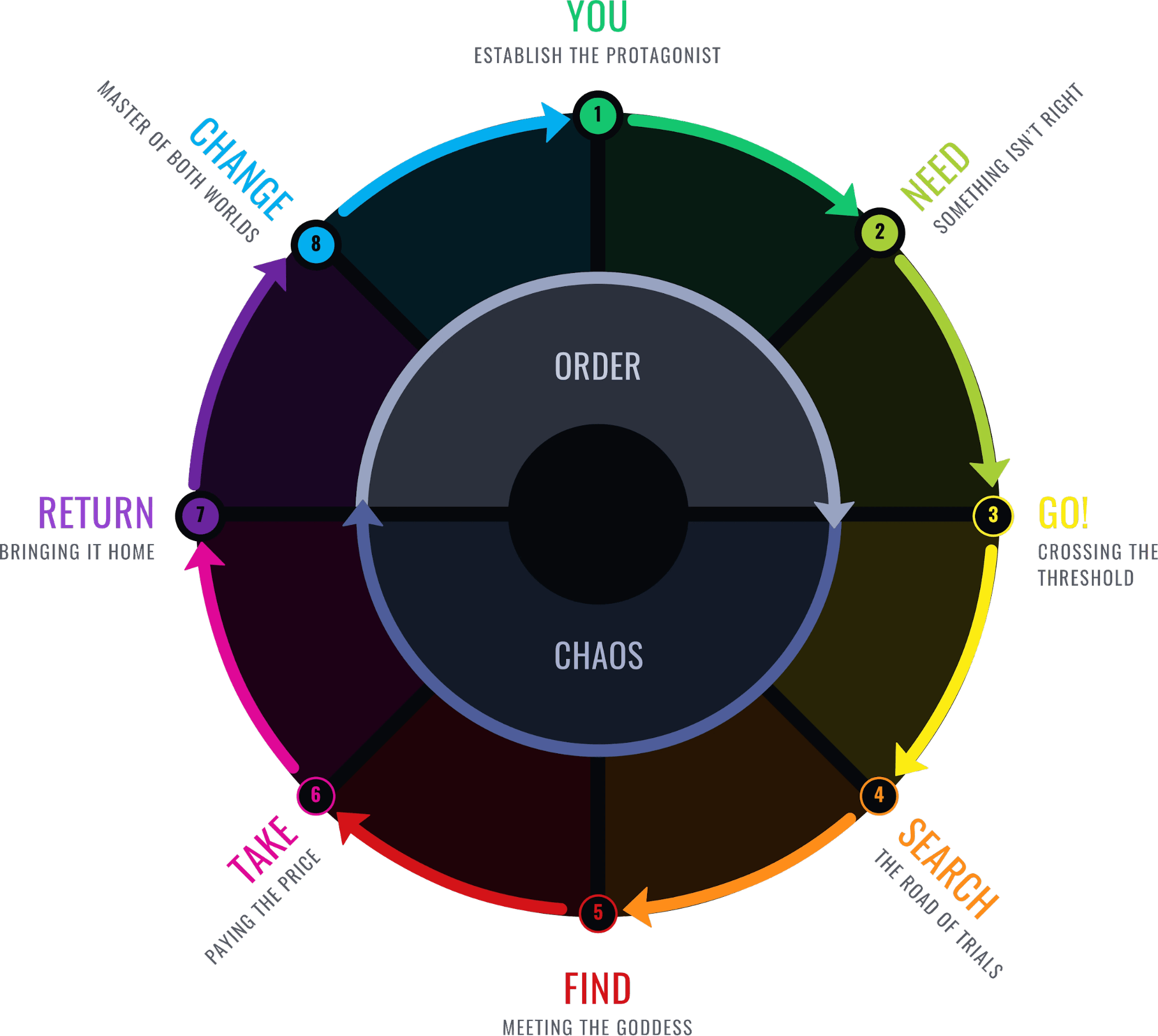You finally started writing that great screenplay idea and put words to paper. But all of a sudden you realize that you may have the foundation of your story, but not the details. This is not an uncommon problem. So we decided to address this uncommon problem and lay out tips that will help you learn how to develop a movie script and write a better story. Let’s dive in.
Developing characters for script writing
Know your character’s goals
Learning how to develop a movie script starts with properly knowing what is at the core of your story. Most stories arguably center around a protagonist. It is important to develop your protagonist, but let’s get a bit more specific.
The driving force behind a story can be distilled down to one word: goal. What is your character’s goal? What do they want? What do they need? What is motivating their actions?
Knowing your character’s goal will inform you on what direction to take a script. It will also inform you on what to create as their obstacles. Iconic screenwriter Aaron Sorkin calls this “intention and obstacle.” In this video Sorkin explains how a character’s intention and goals move the story forward.
Aaron Sorkin Answers • How to develop a story idea
Knowing your character’s goal and intention will give you the compass you need when developing your script. Understand why a goal is important to your character and you will be more prepared to develop the path they take throughout the story.
How to develop a story for film
Create conflict
Of course, a clear goal is not the only thing that makes an engaging story. It must be coupled with conflict. Developing a script is all about finding ways to move the story along while revealing more about your characters. There is no better way to reveal a character’s traits than having them deal with conflict.
How a character responds to conflict, overcomes obstacles, and deals with moral or ethical dilemmas will inform you and your audience on who they are.
This great video essay on creating conflict in story by Tyler Mowrey states that great story conflict has two components: the creation of greater and greater conflict and the succession of events that the point of no return.
How to Develop a Movie Script with Conflict
When developing your script, the question, “What happens next?” will inevitably arise. When it does, try and find an opportunity for conflict whether it is internal or external conflict either big or small.
Related Posts
How to develop a movie script with structure
Utilize story structure
Learning how to develop a story for film is all about developing momentum in a story. So far we’ve talked about what creates momentum (intention and obstacle). Now let’s talk about figuring out where to arrange them in your story. For this we need to refer to story structure. One of the most recently utilized is the Dan Harmon story circle.

Developing the story • Dan Harmon’s Story Circle
Harmon’s story circle builds on other storytelling principles to create eight plot points that give story momentum. In this video essay, we break down Harmon’s story circle so that you can apply it to your own script.
Dan Harmon Story Circle: How to Develop a Movie Script • Subscribe on YouTube
It is important to remember that there is no singular story structure. Harmon’s story circle is only one structure to learn from. There are various principles that screenwriters and filmmakers have outlined that can be applied to a story to make it better. The Hero’s Journey, Three Act structures, or even Nolan’s circular non-linear story structure.
Christopher Nolan’s script development • Subscribe on YouTube
The idea of structure often deters some writers. To some, structure sounds formulaic or less creative. The truth is that story structure can be the missing component that allows your artistry and creativity to flourish.
How to develop a story idea
Identify story problems
As you learn more about structure, you may find that your story doesn’t fit any structure. Determine whether or not this is due to problems in your story.
Lack of Cause and Effect
Mediocre stories are a victim of “and then...” sequences. “And then...” sequences are plot points that occur without real cause and effect. They can lead to boring stories that have no real momentum.
Creators of South Park, Trey Parker & Matt Stone, combat this by focusing on using the words “Therefore” and “But” between story beats. This can help create more interesting, cause and effect sequences.
Script development from Matt Stone & Trey Parker
No philosophical conflict
Another story problem you may identify when analyzing your character’s goals and obstacles is the lack of a philosophical conflict. Don’t let the phrasing deter you. Philosophical conflict is neither scholarly or conceited, but rather a reason for viewers to remember your story.
To create a memorable script that sticks with an audience, try to find philosophical conflict in your story and lean into it no matter how simple.
These can be moral dilemmas, character beliefs, or even a simple battle between good and evil. Take a look at this video essay by Tyler Mowrey for a deeper dive into the philosophical conflict in storytelling.
How to Develop a movie Script • common mistakes
Philosophical conflict is what can make an audience empathize with a character engaging in a story. A beautifully shot film with great performances, but a lack of philosophical conflict can leave an audience thinking, “So what?”
Related Posts
How to Develop a Movie Script
Find inspiration
Perhaps the road block you encounter while developing your script isn’t about goals, conflict, or structure. It is not uncommon to hit a wall and just now know where to go with a script. As is the case with feeding the mind of any artist, you must find inspiration.
Inspiration can come from anywhere at any time. You can simply watch new films, read novels, or go to a museum. Or you can find inspiration from everyday life as you people watch, have conversations, or simply be more attentive to everyday situations.
These can help you overcome script problems or writer's block.
The most important thing is to not let writer’s block paralyze you. Learn to work with writer’s block whether it is on the page in your head exploring new ideas. Here are a few tips from some of the best screenwriters in the business on how they deal with writer’s block.
How to develop a story idea with writers’ block
Writer’s block can be a natural part of the screenwriting process. Great scripts don’t often come easily. Writer’s block or bumps in the road can be a catalyst for seeking out inspiration that will make your story better.
Even when it comes to the visual aspect of developing a script like how a shot will look or the visual style of a film, finding inspiration from other art and real life will give you more to work with.
In this video, one of the best cinematographers of all time, Roger Deakins, talks about how he learned about how light works by being more attentive in everyday situations.
Roger Deakins on "Learning to Light" • Subscribe on YouTube
You will inevitably encounter problems and roadblocks when developing your script. Whether these problems have to do with the visuals, writing, or general story, do not let it discourage you.
Rather, be encouraged to find inspiration elsewhere so that you can come back to the script with fresh eyes and hopefully new ideas.
How to develop a movie script with peers
Collaborate with others
The basis of storytelling is to share a story. Stories are not meant to be kept to yourself. The success of a story is measured by how well it engages an audience. To know how well your script does this, you must collaborate with others.
Try to select a small group of people who you trust to be honest yet constructive to bounce ideas off of and go to for feedback on your script. Collaboration will give you fresh perspectives on a script you might be staring a little too much at.
Some screenwriters even work with another writer. In this interview, actor and screenwriter Zach Braff explains how collaborating with his brother on scripts was a yin and yang give and take that benefited their work.
Zach Braff shares how to develop a story idea
Screenwriters who are just starting out are often very precious about their work. Unfortunately, this can lead to a lack of collaboration and lack of feedback. Try to avoid being overly precious with your script so that you can be open minded to ideas that make it better.
Related Posts
How to develop a story for film
Write then rewrite
Ernest Hemingway once said, “Write drunk. Edit sober.” Before you go to your local liquor store and before hitting the typewriter, let’s clarify what Hemingway meant.
Writing a final draft on your first draft is a fool’s errand. Don’t get caught up on writing a perfect script every time you decide to write. Script development is all about allowing yourself to write freely to get your thoughts on the page.
Then come back to it, edit, and rewrite. In this video, Seth Rogen talks about how writing with a lack of perfectionism will help you purge the bad ideas out and eventually split out a good idea.
Seth Rogen explains how to develop a story idea
This process is much more effective and less frustrating than striving for perfection every time you sit down to write your script. Writing is essentially rewriting. Once you’ve addressed all of the tips above, all that is left is to sit down and get to work.
UP NEXT
What is Three Act Structure?
As we mentioned above, utilizing story structure is one of the best ways to develop a script and create story momentum. One of the oldest story structures in history is the three act structure. Learn more about the three act structure, it's components, and when to use it in our next article.
